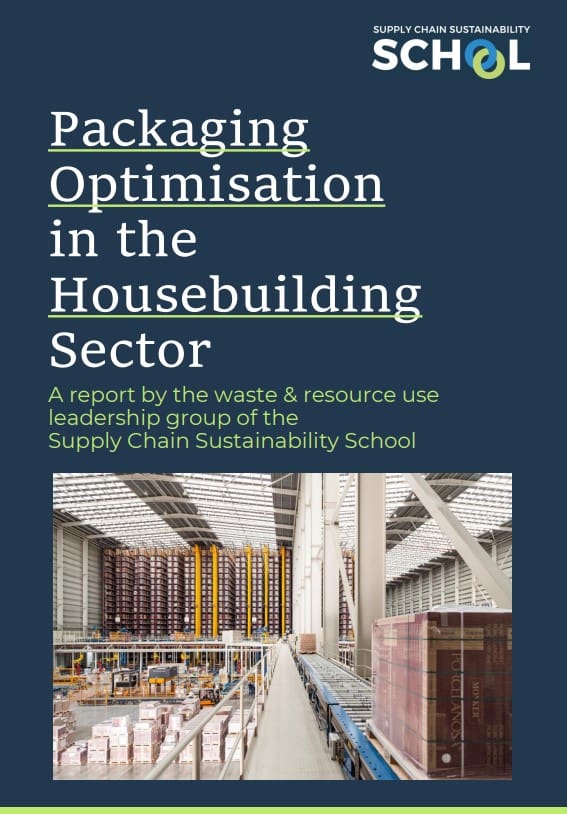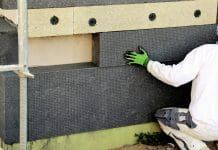Discover how the Supply Chain Sustainability School and its partners have worked to address the relentless packaging challenge facing the built environment, culminating in its recent project report, Packaging Optimisation in the Housebuilding Sector
Packaging is essential to how the built environment industry-especially in the housebuilding sector – currently does business: delivering protection, safe transportation, storage, product identification and a wide range of other benefits. However, it also generates huge ongoing costs and sustainability impacts.
Significant legislative and policy changes addressing packaging are already in place, such as the Plastic Packaging Tax, or around the corner, such as Extended Producer Responsibility.
The tide is beginning to turn in favour of optimising and reducing packaging. More on these two words later.
It is therefore both a commercial and environmental imperative for every affected organisation to develop strategies and practical actions to address these complex challenges.
The housebuilding sector is particularly vulnerable to these challenges, with estimates that around 65% of their light mixed compactable waste volume comes from packaging.
Volume is a key influence on cost and sustainability outcomes, as packaging by its nature frequently takes up a disproportionate amount of space in skips. When it comes to common products, the numbers are staggering.
Conservatively, every year the sector uses around 1.5bn bricks and installs over 1m large appliances such as fridges, cookers and boilers – all contained in various forms of packaging.
Building a business case for action
The Supply Chain Sustainability School operates a waste and resource use leadership group that has been working on these issues for several years.
In 2020, a School survey found that levels of knowledge and insight among the School’s partners and members on the quantities and types of plastics, including plastic packaging, being handled were largely very poor.
With legislation on the horizon and sustainability impetus growing, the School decided to do something to help address this situation.

Work began in 2021 with a project designed to gain a detailed understanding of the packaging associated with all the significant elements of housebuilding supply.
Housebuilding was an ideal sector in which to conduct a structured project, as the supply chain for housebuilding is more predictable than most. It is also the source of the bulk of the sector’s packaging waste.
Put simply, most houses are made largely of the same things: bricks, blocks, tiles, drylining, insulation, doors, windows, kitchens, bathrooms, appliances, consumables and so on.
The supply chain is also remarkably consistent. The original project partners considered that it should therefore be relatively easy to develop a dataset to inform future action.
Reality proved somewhat different as the true complexity of housebuilding supply was revealed, including the critical roles of merchants, subcontractors and transportation agencies.
Taking practical action to optimise packaging in housebuilding
Despite these challenges, a baseline set of workable data was obtained and in due course, a follow-up project was launched.
The agreed aims were to use the collective influence and insights of the project partners to find practical collaborative ways to: optimise volumes and types of packaging needed in housebuilding projects; improve the quality and consistency of recyclability and, ultimately, recycling for packaging that cannot be eliminated; and to influence and publicise examples of collaborative innovation between the project partners and manufacturers/suppliers and, over time, the gains made.
The project partnership
The partnership for this new work involved four of the UK’s biggest and most influential housebuilders – Bellway Homes, Crest Nicholson, Taylor Wimpey and Vistry Group, working in partnership with waste management experts Biffa and Reconomy, together with Ibstock, Stark Group, Saint Gobain and Zero Waste Scotland.
The partners co-funded the project, also donating their time and helping the project team to engage with 23 of their specialist suppliers, manufacturers and merchants.
These organisations were selected to cover all the most significant aspects and trade categories of the housebuilding process. They provided the practical expertise that provides the backbone of the report and their innovations to optimise and reduce packaging are referenced throughout.
Along with the support of the project partners, this has acted as the catalyst for numerous joint projects for mutual benefit.
Why optimisation?
The project hinged on understanding the use of all the most essential packaging elements: wrap, corner and edge protectors, banding, pallets and bearers, protective sheets, bags, boxes and “problem” items, such as mastic cartridges.
Though part of the packaging challenge was indeed to investigate and showcase ways to reduce unnecessary packaging, it was also essential to respect the realities of the challenging conditions encountered in the construction and maintenance of the built environment. Weather exposure and damage on-site are common and can cause valuable materials to become useless.
Therefore, there is a requirement to be pragmatic and to optimise, including circular and reusable packaging options and improved targeting for recyclability for essential single-use items. The project report clearly identifies that packaging is not simply the enemy.
What was achieved?
Outputs included a free-to-access report, Packaging Optimisation in the Housebuilding Sector, and delivery via the School of a virtual conference, Packaging Optimisation Showcase, which highlighted some of the findings.
Five tips within the report for more sustainable packaging point the way for any organisation interested in making changes for the better:
- Question if packaging is needed at all – especially plastic wrap.
- Optimise wrap use by minimising thickness, specifying LDPE or LLDPE using at least 30% recycled content and avoiding excessive use of branding, inks and stickers.
- Switch from plastic and expanded polystyrene to cardboard or pulp for packaging elements which protect products.
- Ensure containers are sized appropriately to reduce the need for additional space packing.
- Engage the whole supply chain to reduce or enable more circular use of pallets.
The report concludes with a threefold message to anyone or any organisation looking to make headway – remember to Classify, Optimise, & Harmonise:
- Classify packaging in a much more detailed way than before. The effort is worth it because of the insights and improvements it could reveal. This will also become essential knowledge as EPR takes hold.
- Optimise as much packaging as possible using the examples from this report for inspiration. This will immediately mitigate risk and help to save money.
- Harmonise still further. Challenge the norms of the role of packaging. Over time, this will make any organisation more circular and sustainable.
What’s next?
Finally, though the project and its report were compiled using evidence from the housebuilding sector, the content is relevant across the entire built environment.
While priorities may change from one sector to another, the principles are highly replicable. From construction to FM, via infrastructure and anything in between, the report provides something for everyone.
Going forward, the School will continue to work with its partners to impact this area for the better and welcomes approaches from any organisation that shares this objective.
Mark Turner
Sector lead – waste and resource use
Supply Chain Sustainability School














![[VIDEO] GBC network calls for boldness at COP29 Baku, Azerbaijan, where COP29 will take place and where the GBC Network have deirected their message](https://www.pbctoday.co.uk/news/wp-content/uploads/2024/11/iStock-513054348-1-218x150.jpg)